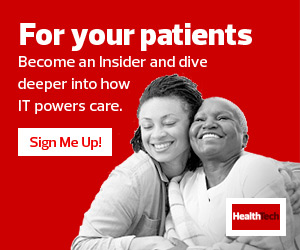How Can Patient Room ‘Next’ Improve Healthcare?
Many healthcare organizations are buying point solutions. For example, clinical leaders may want to solve for patient falls and buy a solution to monitor and address that problem in addition to other solutions already in use. Clinicians may have to log in to three or four apps when they enter a room. If they are getting alarms from multiple sources, it can lead to alarm fatigue. Patient Room ‘Next’ looks to implement fewer solutions that can do more, and to integrate technologies to prevent false alarms by delivering alarms to a single, efficient source.
Many organizations try to solve this problem with virtual desktop and single sign-on technologies. While those solutions are necessary and have a place in clinical workflows, Patient Room ‘Next’ strives to provide an “easy button” with one, integrated solution.
Rather than dealing with alerts coming from different sources, clinicians are better served if they are made aware of alerts instantly in a condensed and integrated way that can augment clinical decision-making. If, for instance, a physician is notified of alerts from sensor one and sensor three simultaneously, in real time, he or she will be able to make better, more fully informed care decisions. This creates efficiencies and satisfaction while improving patient care.
LISTEN: Patient Room 'Next' focuses on the next iteration of healthcare technologies.
One solution being used in the next iteration of patient rooms is Artisight’s Internet of Things sensor network. The technology uses cameras, sensors and microphones to collect data, which is analyzed by artificial intelligence algorithms supported by NVIDIA Clara Guardian. The technology can surface alerts to clinical teams, improving patient care and efficiency by augmenting clinical workflows. As customers use Artisight and communicate clinical needs, the company is adding more functionality to the platform.
The need to turn patients is one example of how monitoring can create clinical efficiencies. A camera that can detect when a patient has turned over lets the nursing staff know that the patient doesn’t need a clinician’s attention to reposition, preventing an unnecessary trip to the patient’s room.
In the machine audio space, there are three main technology types: command and control; ambient listening, which can alert a nurse if the system hears certain noises from a patient; and care companions, which use AI to develop relationships with patients through two-way conversation.
READ MORE: The future of smart hospital strategy brings care to the home.
The Five Goals of Patient Room ‘Next’
The Patient Room ‘Next’ strategy has five main goals:
- The “easy button”: This involves integrating clinical technology solutions into one platform, making it easy for clinicians to access the patient data they need when they need it.
- Real-time data knowledge: Having real-time access to patient telemetry and biometric data in one location can help clinicians make diagnoses and clinical decisions efficiently, based on the best information available.
- Automated documentation: Clinicians spend a lot of their time documenting the care they provide in the electronic health record. Time spent in the EHR can take away from time spent with patients. Automating parts of the documentation process frees clinicians to work at the top of their licenses.
- Touchless technology: Cameras and sensors can enable technology to monitor a patient’s condition without disrupting the patient’s environment. This will eventually expand to include touchless vitals that can be used in a patient’s home.
- Flexible spaces: During the pandemic, many healthcare organizations had to find new spaces to care for ICU patients, such as parking garages or tents in parking lots. The Patient Room ‘Next’ strategy makes it easy for healthcare organizations to transform spaces when needed and then return them to their regular purpose.
DISCOVER: How partner-delivered IT services help mitigate the effects of staff shortages.
IT partners such as CDW and Sirius, a CDW Company, can help healthcare organizations determine which solutions would work best for them, and then install and manage the solutions. If an organization is renovating a floor or planning new construction, having a conversation with a technology partner can ensure that rooms are wired correctly and best positioned to support new technology.
As technology in these spaces matures, an IT partner can help fill in the gaps and integrate solutions to ensure ongoing clinical efficiency and quality patient care.
This article is part of HealthTech’s MonITor blog series. Please join the discussion on Twitter by using #WellnessIT.












